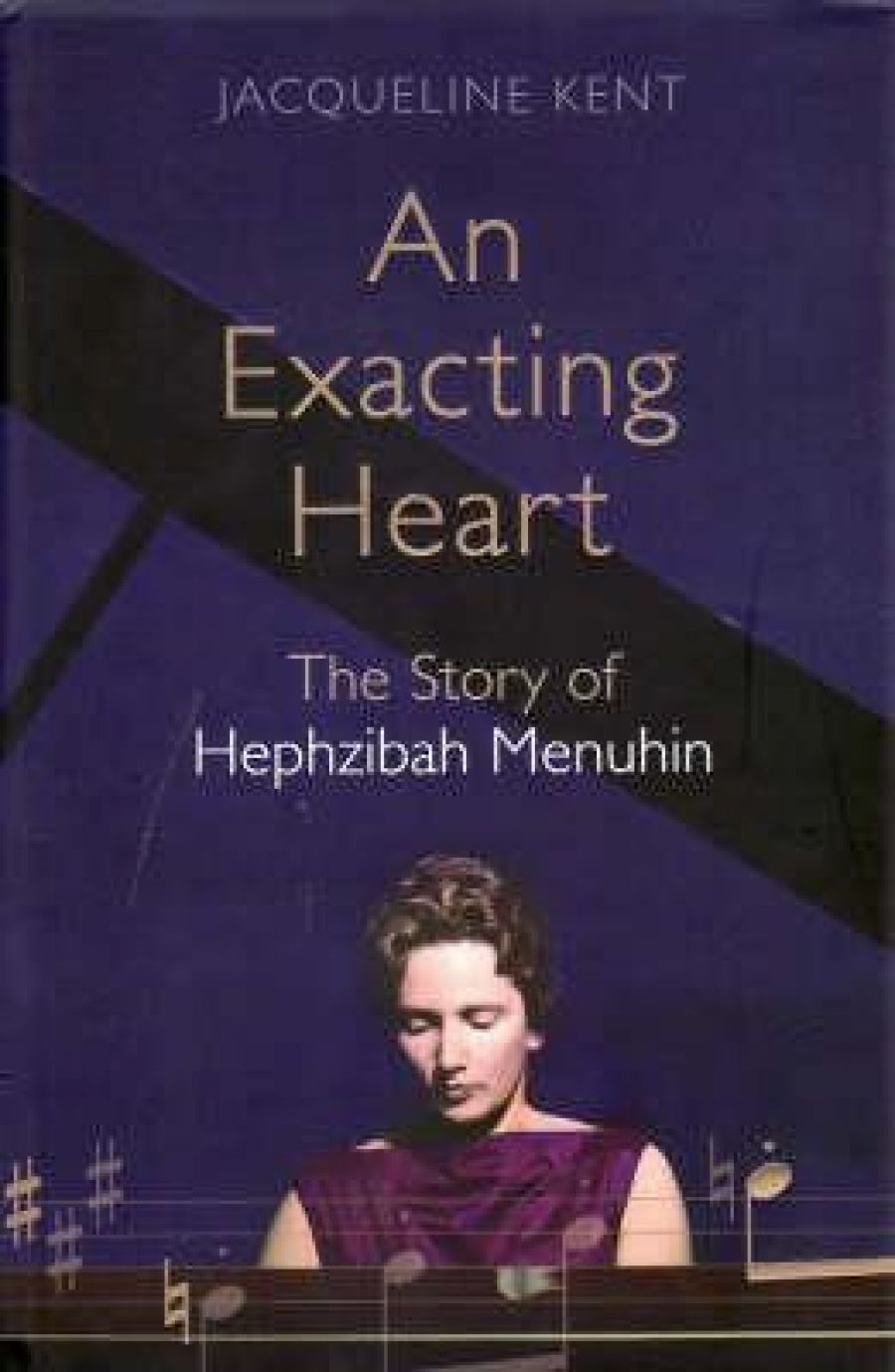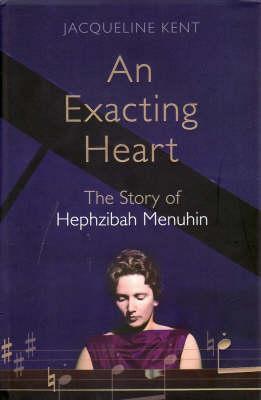
- Free Article: No
- Contents Category: Biography
- Review Article: Yes
- Article Title: Siamese soul
- Online Only: No
- Custom Highlight Text:
In early 1980, Yehudi and Hephzibah Menuhin undertook yet another concert tour. One of their last concerts together was in Valley Forge, Pennsylvania. There was a dismal yellow standard lamp for light and a revolving stage so that all the patrons could get value for money. The master of ceremonies introduced them as ‘Ham-erica’s own ... Yoohoo and Heffi Menhoon’. These exceptional siblings had been playing music together since 1932, usually in more salubrious venues. Yehudi often spoke of their liaison spirituelle and their ‘Siamese soul’. Their first public concert took place in 1934, in the Salle Pleyel in Paris. By 1980 it had become one of the longest and richest partnerships in the history of chamber music.
- Book 1 Title: An Exacting Heart
- Book 1 Subtitle: The story of Hephzibah Menuhin
- Book 1 Biblio: Viking, $49.95 hb, 440 pp
- Book 1 Cover Small (400 x 600):

- Book 1 Cover (800 x 1200):

Yehudi, born in 1916, four years before Hephzibah, was sui generis – the greatest musical prodigy of the twentieth century and ‘the first multi-media classical music star’, as Jacqueline Kent notes in her thoughtful biography of Hephzibah. The son of Russian immigrants to California, Yehudi was internationally famous in his teens, and would remain so until his death (quite deaf but still conducting) in 1999.
Hephzibah ‘s story is much less well known and frequently overlooked in Yehudi’s biographies, partly because of the nature of her two marriages (which drew her, intermittently, away from the recital hall and the recording studio), but mostly because, though abundantly talented and arguably Yehudi’s equal as a musician, she preferred the role of accompanist, not soloist. Her modesty was instinctive, her intellectual interests far too broad for mere stardom. Not for her the peerage and entourages that followed Yehudi; she disliked interviews and ironed her own concert dresses. Her place was always beside Yehudi, deferential, ‘willing him on’. Why she eschewed the life of a concert pianist, and why she made some of the impulsive decisions that she did, are the measured and moving themes of An Exacting Heart: The Story of Hephzibah Menuhin.
Hephzibah’s mother, it has to be said, did not help. Marutha was domineering, censorious, smothering and ambitious – for Yehudi. She and Moshe Mnuchin (later Menuhin) had moved to San Francisco in 1918, and soon recognised their young son’s prodigious talents. He and his two sisters were educated privately, first by their parents, later by tutors. Of her childhood Hephzibah would say, ‘We lived in a completely circumscribed world, totally unaware of anything outside ourselves. It was like another womb.’ When she embraced her mother, ‘it was the unyielding corset that my arms enclosed’.
Hephzibah, in her early teens, was impressively erudite and fluent in French, Italian and German, as well as English. Music came first, always music. Even when it became clear that Hephzibah was as talented as Yehudi, Marutha discouraged her ambitions. Reluctantly, she allowed Hephzibah to give her first solo recital (Beethoven, Bach, Weber, Chopin) at the age of eight, in San Francisco, but later Marutha told a journalist: ‘I always praised Hephzibah far more for a well-balanced dinner and executed dinner cooked by her than for any concert she might ever play.’ Hephzibah never severed relations with Marutha, but she had few illusions. Nearing thirty, she described her mother as ‘a fierce and horrid freak, as full of unspeakable horrors as is a snake of poison and no less venomous’.
Little wonder that all three young Menuhins (including Yaltah, the baby sister) fell into marriages as soon as they possibly could. In 1937, after a recital at the Albert Hall, Bernard Heinze introduced Yehudi and Hephzibah to the two young wealthy Australians, Lindsay and Nola Nicholas, heirs to the Aspirin fortune. Yehudi, quite unworldly, was besotted with Nola and asked her to marry him within about a week; Hephzibah proposed to Lindsay not long after that. Not to be outdone, Yaltah, just sixteen, married someone who had rather fancied Hephzibah.
Hephzibah married Nicholas in Los Gatos, California, in 1938: there is a bizarre photograph of her looking like a plump twelve-year old shepherdess. ‘Henceforth,’ she told her diary, ‘my little career is finished, and well finished.’ Sailing for Australia, she threw overboard the heavily boned corsets that her mother had obliged her to wear. With Nicholas (‘supreme owner of several thousand sheep’, as she put it), she would run the vast property known as Terinallum, in western Victoria. She greeted the neighbours in her long white Russian satin trousers, but with her usual warmth and not a trace of pomposity. Two sons followed in the early 1940s. The music, despite her nuptial vow, soon resumed. When Yehudi toured Australia in 1940, they recorded Brahms and Beethoven violin sonatas for HMV. After the war, Hephzibah became Australia’s premier musical celebrity, as soloist, chamber musician or recording artist.
Until this stage, Hephzibah, as portrayed in the biography, remains likeable but capricious. Then in the late 1940s she becomes fascinating in her own right, much less frivolous and satisfied with her privileged life at Terinallum. A visit in 1947 to the Theresienstadt concentration camp seems to have changed her forever. She became impatient, questioning, newly conscious of her Jewish heritage. Her charity work assumed fresh importance for her. She took in foster children from the poorer parts of Melbourne. Recalling her spinal difficulties in childhood, she decided to buy adjustable desks for primary schoolchildren, and hocked her engagement ring to do so. Presciently, she established a travelling library for underprivileged children – buying the books herself, carting them around Victoria, and doing all the administration work – and soon earned the sobriquet ‘the Red Mrs Nicholas’.
Stagnating, unfulfilled, bored by the amiable and endlessly accommodating Lindsay, Hephzibah began an affair with an Austrian journalist and polyglot living in Melbourne. Her conduct when this was discovered was both naïve and egoistic. Even Jacqueline Kent, an admiring biographer, comments: ‘Hephzibah could be ruthless when it suited her, a quality several people were just beginning to discover.’ The affair soon ended, but a new pattern of independence and restlessness had begun.
She had also become a shrewd observer of people, and a merciless correspondent. When Yehudi and his second wife, the ballet dancer Diana Gould, visited Australasia in 1951, Hephzibah wrote to the latter’s sister. Few correspondents are so searing, especially to the sister of the person they are eviscerating. This brilliant, coruscating letter ends: ‘Mammina, Nola, Diana, me – a sad gallery of bitches to make any man fall out of love forever.’
Almost inevitably, a man came along for whom she was prepared to throw up everything. This was Richard Hauser, another Austrian, who had lost his mother in a concentration camp and who had gone to Palestine to fight in a Jewish unit of the British army. Now in Australia with his wife and daughter (whom we know as Eva Cox), Hauser was a seductive and mysterious character, vain, charismatic, jealous, cynical. His new method of psychological research, sometimes controversial, attracted various kinds of work in government and industry. Before long he and Hephzibah were lovers, defiant ones. Mirka Mora, observing them in her café in the early 1950s, sensed that Hauser had awakened Hephzibah sexually. She idealised Hauser, even ascribing psychic powers to him. Nothing tempered her infatuation, certainly not the threat of scandal. Lindsay was tolerant at first, but eventually he stopped trying to mollify her and refused to part with their two sons. The seeming ease and unsentimentality with which Hephzibah left the boys behind are nothing short of grotesque, as evinced in her letter to Yehudi:
… they are all part of the picture, they served as steps in my long climb out of domestic darkness into the daylight of life’s fulfilment. They served as a most valuable function and each shed a light of its own on the panorama of which I was to become a living part.
Her biographer remains cool, unjudgemental (‘Hephzibah’s self-absorption could be impressive’), and wonders if her ‘emotionally dislocated upbringing’ had influenced her.
Clearly, Hauser was the love of Hephzibah’s life. Her deference, her sacrifices, were immense. Nicholas sued Hephzibah for divorce on the grounds of adultery in 1954, and she and Hauser married the following year, having already moved to Sydney. She steeped herself in his work, as an assistant and co-researcher. She performed with the Sydney Symphony Orchestra under Eugene Goossens, principally to raise money. From now on she lived in flats, in some poverty (the neighbours threw open their windows when she practised). In an unsent letter, she wrote: ‘We have a bigger job in life than hitting keyboards and playing violins for the entertainment of our admirers … we are not circus ponies to be flogged or bribed.’ When her daughter, Clara, was born, Hephzibah used the time in hospital to conduct a survey as to why there was such a paucity of recruits in obstetric nursing.
The Hausers moved to London, where their work was various and exhaustive (‘We call it our heroic period’, she said). They lived in a walk-up apartment in Clapham Common, which appalled Moshe and Marutha, who despised Hauser. In 1962 they published two books, the radiantly titled The Fraternal Society: Towards Freedom from Paternalism and The Homosexual Society: A New Approach to the Problem. Many people distrusted Hauser’s methods and disliked his personality, which grew more dictatorial and intemperate. Hephzibah remained stoic and loyal, despite his promiscuity. Gradually, she became a speaker of force and eloquence. In 1977 she was chosen as British president of the Women’s International League for Peace and Freedom.
That year she was diagnosed with throat cancer. Yehudi encouraged her to treat the cancer by non-surgical methods, possibly hastening her death. Their music-making, which had taken them on regular concert tours of Australia, Europe, North America, even Russia, continued notwithstanding. While Yehudi’s playing rarely matched his glory days, Hephzibah was in superb form. Hauser’s conduct at the end was base: the affairs continued, he urged his wife to tour, and as she was dying he moped, ‘Why is this happening to me?’ Yehudi didn’t behave entirely creditably either, arranging recording sessions and concerts when Hephzibah was dreadfully ill. But the music came first. ‘Such a waste,’ he said later. ‘There was so much we were going to do. We had only been playing together for forty years ... ’
Their sister, Yaltah, writing to Yehudi after Hephzibah’s death in 1981 at the age of sixty, was more acute: ‘She felt she had to pay for everything in full by sacrifice. This still haunts me constantly.’
Thus, movingly, ends this life of an impressively enigmatic woman. Befitting a work by the biographer of Beatrice Davis, the text of An Exacting Heart is flawless. The volume itself is handsomely presented, with marvellous photographs. Extensive notes and references accompany the text. Rather tellingly, there is no discography.


Comments powered by CComment